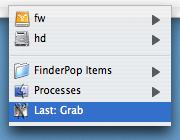

COMPARABLE FINDERPOP CONTEXTUAL MENU MAC
Select This Mac from the "search criteria" bar in the window that appears.Select File → New Smart Folder from Finder's menu.To create a persistent Smart Folder in Finder that collects all files tagged with particular tags, do the following: Quit Tagger and discard any changes you've made by pressing Esc or Command-Q, or by closing the window.Commit your changes by either clicking on the "Save" button or by pressing Command-Return (or the Return key twice in a row, if you've turned this feature on in the preferences) when the focus is in the tags field.When you're done editing the tags, you can: $ open -a Tagger "/path/to/file1" "/path/to/file2" path/to/some other file" -t "Two files" If you don't need to specify a custom title, you can then simply use the open command like this: $ /path/to/Tagger.app/Contents/MacOS/Tagger -f "/path/to/a file to tag In order to specify more than one file, separate the paths of those files by new lines. If you would prefer to launch Tagger via the command line (a shell script, for example,) you can specify the files to tag with the -f argument and the title to show in the main window with the -t argument. If you keep Tagger in your dock it'll always be easy to access for this. If you drag & drop files on top of Tagger, it will launch and let you tag those files. Files under this path are indexed by Spotlight and backed up by Time Machine by default. webloc) files that point to the tagged web page addresses and are saved in ~/Library/Metadata/Tagger/Web Links/. Currently supported web browsers are Safari, Opera, Camino, OmniWeb and Firefox (Note: Support for Firefox is very unstable due to Firefox's buggy AppleScript interface.) Tags that you add to web pages this way will be assigned to "web internet location" (. If the currently active application is a supported web browser, Tagger will, when launched, let you tag the web page that you have open there. Launch Tagger when the frontmost application is a supported web browser.Drag a link to Tagger into the Finder toolbar:.Add a "Tag" item into your Finder context menu using FinderPop by creating an alias (called "Tag") for Tagger into the FinderPop items folder:.Configure a global hotkey/shortcut using for example Spark or Keyboard Maestro.This way, you'll be able to launch Tagger in any way that you'd like. You can simply let Tagger ask Finder (or Path Finder - whichever happens to be the frontmost application) for the currently selected files when it launches and let you tag them. Select file(s) in Finder or Path Finder → launch Tagger.Note: In order to enable this feature, you need to select the "Enable access for assistive devices" option in the "Universal Access" preference pane in System Preferences. This way, you can use whichever quick way of launching Tagger you would prefer (Spotlight or Quicksilver, for example, or a global hotkey via Spark, Keyboard Maestro or some other similar application. If the currently active window in whichever application you're using is a Cocoa document window, Tagger will, when launched, let you tag that document. Simply launch Tagger when the frontmost application window is a document window.

You tell Tagger which file(s) you want to tag when launching it.


 0 kommentar(er)
0 kommentar(er)
